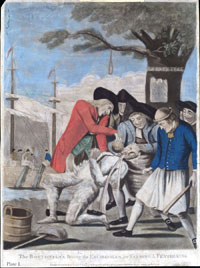Boston

The city of Boston was first settled in 1630 when Massachusetts Bay Governor John Winthrop decided to relocate the Puritan community at nearby Charlestown to a site with better water. Boston was established on a rocky peninsula on the Charles River that had harbor access and could be defended easily. The city developed with an irregular street plan that accommodated the hilly topography. Clustered around an open market at the center of town were a meeting house, town hall, and the governor’s home. The growth of maritime-based industries such as shipping and fishing led to the construction of wharves and a commercial district along the harbor.
Boston had a population of 16,000 people by the time of the Revolution. Although smaller than New York and Philadelphia, the city wielded considerable political influence. Years of civilian unrest caused by dissatisfaction with British policies led to conflicts such as the Boston Tea Party and Boston Massacre. Parliament’s Boston Port Act and subsequent blockade of the harbor stirred the anger of other American colonies. The Revolution began with the outbreak of hostilities at the Battle of Concord and Lexington, about 20 miles from Boston.









